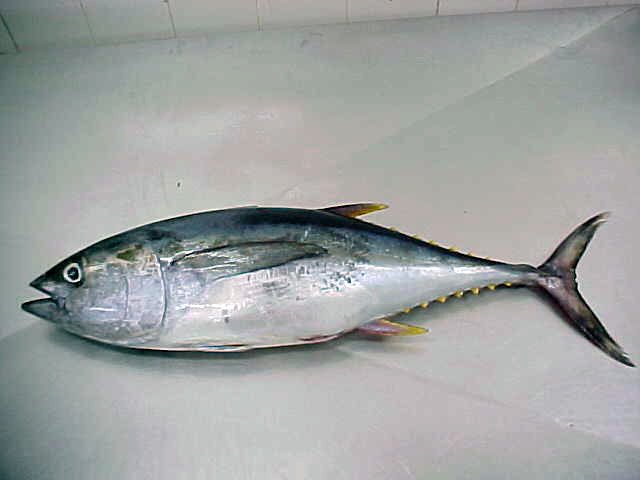Types of tuna fish
Long ago, fishermen were free to fish wherever they want to and there was also no control of their catch. However, since to export fish to the European Markets, several rules and regulations have been set up to:
The Albacore Tuna has long pectoral fins that reach to a point beyond the anal fin on its body. This fish is dark blue to greenish blue along the back and silvery white along its belly. Albacore Tuna has yellow dorsal fins.
Habitat: Tropical, subtropical and temperate waters and they prefer deep, wide open waters. Feeding habits: Fish, squids and crustaceans. The Albacore Tuna usually feed in schools which can also include tunas of other families.
(2) Yellowfin Tuna
The Yellowfin Tuna is a fish swimming at high speed and endurance. Its belly is patterned with numerous broken lines and it has a vivid golden stripe along each side of its body. The Yellowfin Tuna has a tendency to move along schools of fish of the same size and they can be seen swimming along the surface of the sea together with the SkipJack Tuna and the Bigeye Tuna.
Bonito Tuna has striped backs and silvery bellies. They can be recognised by their narrow tailed based, with a forked tail and a row of small finlets behind the dorsal and anal fins.
The Indian Ocean is among the world's main tuna catching areas in the world. It is in fact the 2nd largest ocean in tons caught, with 24% of the (total) global catch. The Mauritian port and Freeport has during the past years, been offering quality and high standard logistics services, infrastructure facilities for fishing vessels, among many other facilities to ensure the rapid transhipment of fish (tuna being the most common fish species being transhiped) in Mauritius.
 |
| Indian Ocean |
- make sure that the stocks of fish caught is dolphin safe
- control the fishing of undersized fish
- inspect the fishing vessels before landing at any port
- make sure that proper fishing methods have been used
Yellowfin Tuna fishing in Mauritius
There are several types of tuna fish that are brought to the Mauritian port; for processing, for sale on the local market or for export. The Figure below illustrates 5 types of tuna namely Albacore Tuna, Yellowfin Tuna, SkipJack Tuna, Bigeye Tuna and Bonito Tuna.
(1) Albacore Tuna
| Albacore Tuna |
The Albacore Tuna has long pectoral fins that reach to a point beyond the anal fin on its body. This fish is dark blue to greenish blue along the back and silvery white along its belly. Albacore Tuna has yellow dorsal fins.
Habitat: Tropical, subtropical and temperate waters and they prefer deep, wide open waters. Feeding habits: Fish, squids and crustaceans. The Albacore Tuna usually feed in schools which can also include tunas of other families.
(2) Yellowfin Tuna
| Yellowfin Tuna |
Habitat: Epi-pelagic zone of the ocean - temperatures of 18-30 degrees Celsius, at depths less than 100 m. Feeding habits: Fish, squid, cuttlefish, octopus, shrimp, lobster and oceanic crabs.
(3) Skipjack Tuna
The Skipjack Tuna are medium sized fish species with black stripes and lots of scales on their body. They are usually cannibalistic by nature and are very mobile by nature. Habitat: Equatorial water. Feeding habits: Mollusks, fish, crustaceans and cephalopods.
(3) Skipjack Tuna
 |
| Skipjack Tuna |
(4) Bigeye Tuna
The Bigeye Tuna is easily distinguished by large eyes; hence its name. They have moderately long pectoral fins with yellow dorsal and anal fins. They have distinctive depths distribution and vertical movement patterns. At night, they usually live in uniformed temperature surface and can descend to greater than 500 m depth at night. Their large eyes have been well developed in adaptation to the aquatic environment (Catching and detecting preys, mate recognition, feeding, and other behaviors). Feeding habits: Carnivorous (Experiments have found that their stomach are usually full of crustaceans and cephalopods.
 |
| Bigeye Tuna |
The Bigeye Tuna is easily distinguished by large eyes; hence its name. They have moderately long pectoral fins with yellow dorsal and anal fins. They have distinctive depths distribution and vertical movement patterns. At night, they usually live in uniformed temperature surface and can descend to greater than 500 m depth at night. Their large eyes have been well developed in adaptation to the aquatic environment (Catching and detecting preys, mate recognition, feeding, and other behaviors). Feeding habits: Carnivorous (Experiments have found that their stomach are usually full of crustaceans and cephalopods.
(5) Bonito Tuna
 |
| Bonito Tuna |
Bonito Tuna has striped backs and silvery bellies. They can be recognised by their narrow tailed based, with a forked tail and a row of small finlets behind the dorsal and anal fins.

Comments
Post a Comment